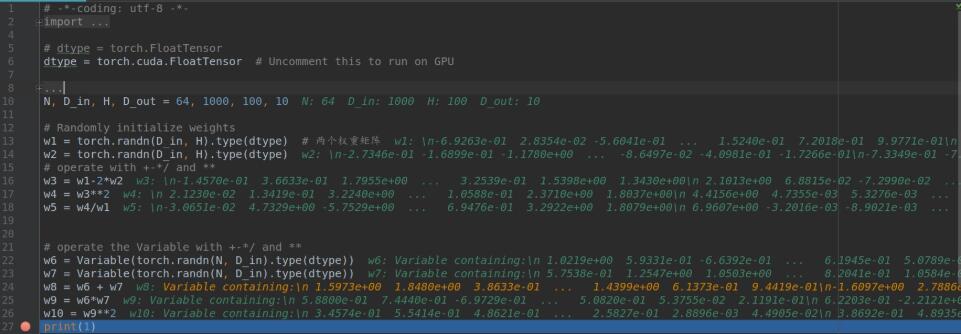您好,登錄后才能下訂單哦!
您好,登錄后才能下訂單哦!
FloatTensor與Variable怎么在Pytorch中使用?相信很多沒有經驗的人對此束手無策,為此本文總結了問題出現的原因和解決方法,通過這篇文章希望你能解決這個問題。
pytorch中基本的變量類型當屬FloatTensor(以下都用floattensor),而Variable(以下都用variable)是floattensor的封裝,除了包含floattensor還包含有梯度信息
pytorch中的dochi給出一些對于floattensor的基本的操作,比如四則運算以及平方等(鏈接),這些操作對于floattensor是十分的不友好,有時候需要寫一個正則化的項需要寫很長的一串,比如兩個floattensor之間的相加需要用torch.add()來實現
for step in range(config.total_step): # Extract multiple(5) conv feature vectors target_features = vgg(target) # 每一次輸入到網絡中的是同樣一張圖片,反傳優化的目標是輸入的target content_features = vgg(Variable(content)) style_features = vgg(Variable(style)) style_loss = 0 content_loss = 0 for f1, f2, f3 in zip(target_features, content_features, style_features): # Compute content loss (target and content image) content_loss += torch.mean((f1 - f2)**2) # square 可以進行直接加-操作?可以,并且mean對所有的元素進行均值化造作 # Reshape conv features _, c, h, w = f1.size() # channel height width f1 = f1.view(c, h * w) # reshape a vector f3 = f3.view(c, h * w) # reshape a vector # Compute gram matrix f1 = torch.mm(f1, f1.t()) f3 = torch.mm(f3, f3.t()) # Compute style loss (target and style image) style_loss += torch.mean((f1 - f3)**2) / (c * h * w) # 總共元素的數目?
其中f1與f2,f3的變量類型是Variable,作者對其直接用四則運算符進行加減,并且用python內置的**進行平方操作,然后
# -*-coding: utf-8 -*- import torch from torch.autograd import Variable # dtype = torch.FloatTensor dtype = torch.cuda.FloatTensor # Uncomment this to run on GPU # N is batch size; D_in is input dimension; # H is hidden dimension; D_out is output dimension. N, D_in, H, D_out = 64, 1000, 100, 10 # Randomly initialize weights w1 = torch.randn(D_in, H).type(dtype) # 兩個權重矩陣 w2 = torch.randn(D_in, H).type(dtype) # operate with +-*/ and ** w3 = w1-2*w2 w4 = w3**2 w5 = w4/w1 # operate the Variable with +-*/ and ** w6 = Variable(torch.randn(N, D_in).type(dtype)) w7 = Variable(torch.randn(N, D_in).type(dtype)) w8 = w6 + w7 w9 = w6*w7 w10 = w9**2 print(1)
基本上調試的結果與預期相符

看完上述內容,你們掌握FloatTensor與Variable怎么在Pytorch中使用的方法了嗎?如果還想學到更多技能或想了解更多相關內容,歡迎關注億速云行業資訊頻道,感謝各位的閱讀!
免責聲明:本站發布的內容(圖片、視頻和文字)以原創、轉載和分享為主,文章觀點不代表本網站立場,如果涉及侵權請聯系站長郵箱:is@yisu.com進行舉報,并提供相關證據,一經查實,將立刻刪除涉嫌侵權內容。